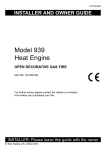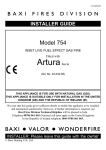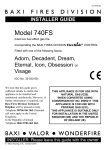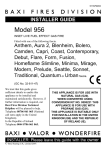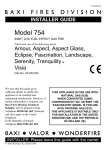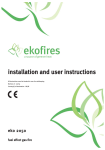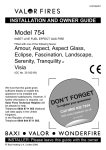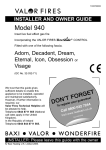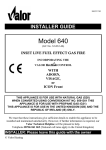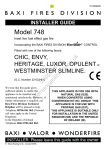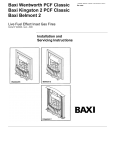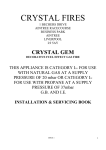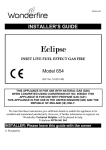Download 739 DGF Valor and Wonderfire install
Transcript
5113426/01 INSTALLER GUIDE Model 739 OPEN DECORATIVE GAS FIRE (GC No. 32-032-54) THIS APPLIANCE IS FOR USE WITH NATURAL GAS (G20). WHEN CONVERTED USING CONVERSION KIT NO. 0595211 THIS APPLIANCE IS FOR USE WITH PROPANE GAS (G31). THIS APPLIANCE IS SUITABLE ONLY FOR INSTALLATION IN THE UNITED KINGDOM (GB) AND THE REPUBLIC OF IRELAND (IE). We trust that this guide gives sufficient details to enable this appliance to be installed and maintained satisfactorily. However, if further information is required, our Baxi Fires Division Technical Helpline will be pleased to help. Please telephone 08706 061 065 (National call rates apply in the United Kingdom) In the Republic of Ireland telephone 0044 8706 061 065 INSTALLER: Please leave this guide with the owner © Baxi Heating U.K. Ltd. INSTALLER GUIDE Safety First. Baxi Fires Division fires are CE Approved and designed to meet the appropriate British Standards and Safety Marks. Quality and Excellence. At the heart of every Baxi Fires Division fire. All Baxi Fires Division fires are manufactured to the highest standards of quality and excellence and are manufactured under a BS EN ISO 9001 quality system accepted by the British Standards Institute. The Highest Standards Baxi Fires Division is a member of the Society of British Gas Industries which works to ensure high standards of safety, quality and performance. Careful Installation Baxi Fires Division is a CORGI registered company. All our gas fires must be installed by a competent CORGI Registered Installer in accordance with our Installer Guide and should not be fitted directly on to a carpet or floor of combustible material. Baxi Fires Division, Erdington, Birmingham B24 9QP www.firesandstoves.co.uk Because our policy is one of constant development and improvement, details may vary slightly from those given in this publication Page 2 INSTALLER GUIDE CONTENTS Section Page 1. SAFETY 2. LIST OF ACCESSORIES 3. APPLIANCE DATA 4. GENERAL INSTALLATION REQUIREMENTS 5. UNPACKING 6. INSTALLATION OF APPLIANCE 7. BURNER AND SUPPLY PIPE INSTALLATION 8. FITTING THE FIREFRONT 9. FITTING THE CERAMIC FUEL EFFECT 10. FULL OPERATING CHECKS 11. SERVICING & PARTS REPLACEMENT 11.1 Checking the aeration setting of the burner. 11.2 To remove the complete burner unit. 11.3 To remove the pilot unit. 11.4 To remove the gas valve. 11.5 To remove the piezo generator. 11.6 To grease the control tap. 11.7 To replace the burner. 11.8 To remove the main burner injector. 3 4 5 6 13 14 16 18 19 20 22 22 23 23 23 24 24 24 25 1. SAFETY Installer Before continuing any further with the installation of this appliance please read the following guide to manual handling: ! ! ! ! ! ! ! ! The lifting weight of this appliance (DGF burner) is 9 kg. One person should be sufficient to lift the fire. If for any reason this weight is considered too heavy then obtain assistance. When lifting always keep your back straight. Bend your legs and not your back. Avoid twisting at the waist. It is better to reposition your feet. Avoid upper body/top heavy bending. Do not lean forward or sideways whilst handling the fire. Always grip with the palm of the hand. Do not use the tips of fingers for support. Always keep the fire as close to the body as possible. This will minimise the cantilever action. Use gloves to provide additional grip. Always use assistance if required. Page 3 INSTALLER GUIDE 2. LIST OF ACCESSORIES Valor and B&Q models Description Part Number All Models LPG Conversion kit 0595211 ‘Quattro’ / ‘Anthem’, ‘Majestic’ and Models not supplied with a firefront Replacement Chair brick 0552311 Replacement Chair brick Trims ! Flat Brass effect ! Flat Satin Chrome effect ! Flat Black 0552321 0552331 0552341 ‘Azure’ Model Replacement Chair brick 0552301 Wonderfire models Wonderfire ‘Gasflame 3 Convector box’ and 16inch Wonderfire Models Replacement Chair brick 0552311 Replacement Chair brick Trims ! Flat Brass effect ! Flat Satin Chrome effect ! Flat Black 0552321 0552331 0552341 Aspire trims with firefronts ! Satin Chrome effect ! Brass effect ! Black ! Copper effect 9820111 9820112 9820113 9820114 Bauhaus Firefront (16 inch Fret) ! Polished Brass effect ! Satin Chrome effect ! Charcoal Black 9800121 9800122 9800123 Page 4 INSTALLER GUIDE Description Part Number Blenheim Firefront (16 inch Fret) ! Brass effect ! Antique (Black & Brass effect) ! Chrome effect ! Black Cast Iron with Brass Finials Blenheim Firefront (18 inch Fret) ! Brass effect ! Antique (Black & Brass effect) ! Chrome effect ! Black Cast Iron with Brass Finials 9800040 9800075 9800076 9800039 9800082 9800083 9800084 9800081 Wonderfire liberty models Liberty Casting ! Chrome effect ! Gold effect 0503701 0503711 Liberty flue boxes ! Liberty Flue box with Gold effect Trim ! Liberty Flue box with Chrome effect Trim 0503721 0503731 3. APPLIANCE DATA This product uses fuel effect pieces containing Refractory Ceramic Fibres (RCF), which are man-made vitreous silicate fibres. Excessive exposure to these materials may cause irritation to eyes, skin and respiratory tract. Consequently, it is important to take care when handling these articles to ensure that the release of dust is kept to a minimum. To ensure that the release of fibres from these RCF articles is kept to a minimum, during installation and servicing we recommend that you use a HEPA filtered vacuum to remove any dust and soot accumulated in and around the fire before and after working on the fire. When replacing these articles we recommend that the replaced items are not broken up, but are sealed within a heavy duty polythene bag, clearly labelled as RCF waste. This is not classified as “hazardous waste” and may be disposed of at a tipping site licensed for the disposal of industrial waste. Protective clothing is not required when handling these articles, but we recommend you follow the normal hygiene rules of not smoking, eating or drinking in the work area and always wash your hands before eating or drinking.This appliance does not contain any component manufactured from asbestos or asbestos related products. This appliance does not contain any components manufactured from asbestos or asbestos related products. Page 5 INSTALLER GUIDE Gas Natural (G20) Propane (G31) * Inlet Pressure 20mbar 37mbar Input - Max. (Gross) 6.85kW (23,400 Btu/h) 6.7kW (22,860 Btu/h) Input - Min. (Gross) 2.3kW (7,850 Btu/h) 4.0kW (13,650 Btu/h) Burner Test Pressure (Cold) 20.0 ± 1.0mbar (8.0 ± 0.4in w.g.) 37.0 ± 1.0 mbar (14.85 ± 0.4in w.g.) Gas Connection 8mm pipe 8mm pipe Burner Injector Stereomatic Cat 82 - 074 Stereomatic Size 132 Copreci Ref. O.D.S 21500/166 Copreci Ref. O.D.S 21500/166 Fitted with RBM 180 -02 injector Ignition Integral Piezo Spark Integral Piezo Spark Aeration See section 11.1 Non-adjustable Pilot & Atmosphere Sensing Device *When converted using kit 0595211 4. GENERAL INSTALLATION REQUIREMENTS 4.1 The installation must be in accordance with these instructions. For the user’s protection, in the United Kingdom it is the law that all gas appliances are installed by competent persons in accordance with the current edition of the Gas Safety (Installation and Use) Regulations. Failure to install the appliance correctly could lead to prosecution. The Council for the Registration of Gas Installers (CORGI) requires its members to work to recognised standards. In the United Kingdom the installation must also be in accordance with: All the relevant parts of local regulations. All relevant codes of practice. The relevant parts of the current editions of the following British Standards:BS 1251 BS 4543 Part 2 BS 5440 Part 1 BS 5440 Part 2 BS 5871 Part 3 BS 6461 Part 1 BS 6891 BS 8303 Page 6 INSTALLER GUIDE In England and Wales, the current edition of the Building Regulations issued by the Department of the Environment and the Welsh Office. In Scotland the current edition of the Building Standards (Scotland) Regulations issued by the Scottish Executive. In Northern Ireland, the current edition of the Building Regulations (Northern Ireland) issued by the Department of the Environment for Northern Ireland. In the Republic of Ireland the installation must also conform with the relevant parts of: The current editions of:IS 813 “Domestic Gas Installations” ICP3 IS327 All relevant national and local rules in force. Where no specific instructions are given, reference should be made to the relevant British Standard Code of Practice. 4.2 In the United Kingdom,as supplied the appliance can be installed in the following situations: For installations with the 'Liberty' casting. ! To a fireplace complete with surround and hearth as shown in figure 2 and complying with BS1251. The required fireplace, hearth, and clearance dimensions are shown in figure 2. For fireplace openings having dimensions different to those shown in figure 2 refer to Table 1 and BS 5871-Part 3 for flue sizes. Note: The Liberty Chamber box is approved for use with a 175mm diameter flue pipe. See BS6461 Part 1 for suitable materials. The minimum effective height of the flue must be 3m. For installations without the 'Liberty' casting ! To a fireplace complete with surround and hearth as shown in figure 1 and complying with BS1251. The required fireplace, hearth, and clearance dimensions are shown in figure 1. Into a fireplace that has a fireback of nominal size 400mm and conforming to BS1251. Into a Replacement Chair Brick as below: ! ‘Quattro’, ‘Anthem’, ‘Majestic’ and models not supplied with a firefront Into a Baxi fires division Replacement Chairbrick. Part number 0552311 ! ‘Azure’ model Into a B&Q Replacement Chairbrick. Part number 0552301 Suitable flues and minimum flue sizes are as follows: 225mm x 225mm conventional brick flue. 175mm diameter lined brick or stone flue. Page 7 INSTALLER GUIDE 200mm diameter factory made insulated flue manufactured to BS4543. 175mm diameter flue pipe. See BS6461 Part 1 for suitable materials. The minimum effective height of the flue must be 3m. The flue must not be used for any other appliance or application. Any chimney damper or restrictor should be removed. If removal is not possible, they must be secured in the open position. If the appliance is intended to be installed to a chimney that was previously used for solid fuel, the flue must be swept clean prior to installation. All flues should be inspected for soundness and freedom from blockages. 4.3 If the fireplace opening is an underfloor draught type, it must be sealed to stop any draughts. 4.4 The appliance must be mounted behind a non-combustible hearth (N.B. conglomerate marble hearths are considered as non-combustible). The appliance can be fitted to a minimum class “O” – 100°C surround. The hearth material must be at least 12mm thick. The periphery of the hearth (or fender) should be at least 50mm above floor level to discourage the placing of carpets or rugs over it (See figure 1). The surface of the hearth must be sufficiently flat to enable the bottom of the front surround and the bottom front cover to be aligned horizontally. Any excessive unevenness (uneven tiles, Cotswold stone, etc.) should be rectified. 4.4.1. 'Hole-in-the-wall' Installations For installation without the 'Liberty' casting ! It is recommended that a hearth should be installed as in figure 1. For installation with the 'Liberty' casting ! It is recommended that a hearth should be installed as in figure 2. For installation with and without the 'Liberty' casting ! If a reduced depth Hearth is fitted, the fire must be installed so that the distance from the base of the fireplace opening in the wall to the finished floor level is 75mm minimum. It is recommended that the reduced hearth has a depth from the fixing plane of the fire of 100mm minimum. This is necessary to support the lower front casting. The minimum shelf height will have to be taken from the base of the fireplace opening. 4.5 If the Fireplace opening is greater than the acceptable dimensions given in this guide, do not use the back of a fire surround or marble to reduce the opening. This may cause cracking of the surround back or marble 4.6 The appliance must not stand on combustible materials or carpets. Page 8 INSTALLER GUIDE Figure 1. Hearth and fireplace opening Figure 2. Hearth and fireplace opening for installations using the LIBERTY CASTING ONLY Page 9 INSTALLER GUIDE Table 1. Flue sizing table. Page 10 INSTALLER GUIDE 4.7 The minimum height from the top of the hearth to the underside of any shelf made from wood or other combustible materials is as follows: ! For a shelf up to 150mm deep Minimum height = 860mm. ! For a shelf deeper than 150mm 860mm + 12.5mm for every 25mm depth over 150mm (See Graph 1). Graph 1. Combustible shelf clearances 4.8 Note that soft wall coverings (e.g. embossed vinyl, etc.) are easily affected by heat. They may scorch or become discoloured when close to a heating appliance. Please bear this in mind when installing. 4.9 This appliance must not be installed in any room that contains a bath or shower or where steam is regularly present. 4.10 An extractor fan may only be used in the same room as this appliance, or in any area from which ventilation for the appliance is taken, if it does not affect the safe performance of the appliance. Note the spillage test requirements detailed further on in this manual. If the fan is likely to affect the appliance, the appliance must not be installed unless the fan is permanently disconnected. 4.11 Normal adventitious ventilation is usually sufficient to satisfy the ventilation requirements of this appliance. In GB reference should be made to BS 5871 Part 2 and in IE reference should be made to the current edition of IS 813 “Domestic Gas Installations” which makes clear the conditions that must be met to demonstrate that sufficient ventilation is available. Page 11 INSTALLER GUIDE 4.12 Propane gas appliances must not be installed in a room that is built entirely below ground level (see BS 5871 Part 3). 4.13 If the appliance is to be fitted against a wall with combustible cladding, the cladding must be removed from the area shown in figure 3 4.14 Combustible side projections up to 75mm forward of the fixing plane of the fire are to be a minimum of 125mm from the fireplace opening (See figure 4) 4.14.1 Combustible side projections greater than 75mm forward of the fixing plane of the fire are to be a minimum of 178mm from the fireplace opening (See figure 4). Figure 3. Removal of combustible cladding Firefront Azure Quattro / Anthem Majestic Dimension 'X' (mm) 400 390 400 Figure 4. Appliance dimensions Page 12 Dimension 'Y' (mm) 65 65 50 INSTALLER GUIDE 4.14.2 Non-combustible side projections to be 75mm from the fireplace opening (See figure 4) 4.15 The appliance is fitted with an A.S.D (Atmosphere sensing device). If the appliance closes down after a period of operation for no apparent reason, the consumer should be informed to stop using the appliance until the installation and appliance have been thoroughly checked. The A.S.D will shut the appliance down if an unacceptable amount of harmful products of combustion accumulate. Under no circumstances should the A.S.D be altered or bypassed in any way. Only a genuine manufacturers replacement part should be fitted. The individual A.S.D components are not replaceable. 4.16 A fireguard complying with BS 8423 should be fitted for the protection of young children, the elderly, or the infirm. 5. UNPACKING Contents: 1 Burner assembly 1 Nut & olive for 8mm inlet pipe 2 Screws 2 Plastic screw plugs 1 Fuel bed matrix support plate 2 Self tapping screws 1 Inlet ‘T’ connector 1 Ceramic fuel effect pack. For models supplied with a firefront 1 Firefront and Cover Carefully remove the contents. Take special care in handling the ceramic fuel effect pieces. Check that all the listed parts are present and in good condition. Page 13 INSTALLER GUIDE 6. INSTALLATION OF APPLIANCE INSTALLATION 6.1 Fireplace size. The fireplace must comply with the requirements described in section 4. 6.2 Fireplace flue pull. Visually inspect the flue for any obstruction, and that a smooth transition from the fireplace opening into the flue is available. Close all doors and windows in the room in which the appliance is to be installed. After confirming with a match that smoke is drawn into the flue, light a 13 gram smoke pellet and check that there is a definite flow through the flue. Verify outside that the smoke exits from one terminal only and that the termination is suitable. Observe, where possible, upstairs rooms and loft spaces for signs of escaping smoke indicating a defective flue. If there is not a definite flow warm the flue for a few minutes and repeat the smoke pellet test. If there is still no definite flow the flue may need remedial work – Do not fit the appliance until there is a definite flow through the flue. IMPORTANT Before continuing with the installation of this gas fire the aeration setting on the burner must be checked. This is factory set. See section 12.1 (Servicing and parts replacement). 6.3 Installation of the burner unit 6.3.1 Prior to installation of the burner the rear support plate must be fitted (See figure 5). Two self-tapping screws retain the plate. Figure 5. Fitting the rear support plate Page 14 INSTALLER GUIDE 6.3.2 Burner Positioning The two tags at the side of the burner can be folded against the side of the burner tray. This may be required for installations where the width of the fireplace opening is restricted (See figure 6) For installations without the 'Liberty' casting ! Place the burner unit centrally within the fireplace opening. Position the burner to the rear of the opening, this may be moved forward providing the front of the burner tray does not protrude beyond the front plane of the fireplace opening by more than 33mm (See figure 7). Figure 6. Burner tags For installations with the 'Liberty' casting ! Place the casting centrally within the fireplace opening. Position the casting to the rear of the opening. The casting may be moved forward providing the inner front curve of the casting does not protrude beyond the front plane of the fireplace opening by more than 33mm Figure 7. Burner positioning (See figure 8). Figure 8. Liberty casting positioning Page 15 INSTALLER GUIDE 6.3.3 Locating the burner. ! Place the burner assembly in position (If installing into a 'Liberty' casting the rear support plate on the burner must touch the rear inner edge of the casting. See figure 9). ! Mark on the fireplace floor the position of the fixing holes in the bracket that is attached to the rear of the front leg. There are two holes in this bracket to prevent burner movement in use (See figure 10). ! Remove the burner assembly. ! Using a 6mm masonry drill, drill Figure 9. Locating the burner into the Liberty into the hearth at the marked casting. position. ! Insert the supplied screw plugs. ! Remove the fixing bracket from the front leg by undoing the screw. ! Place the bracket in position on the fireplace floor and fix in position using the woodscrews provided. ! Place the burner assembly back in position and attach to the bracket by refitting the screw. Figure 10. Locating the burner 7. BURNER AND SUPPLY PIPE INSTALLATION A nut and olive is provided for an 8mm-pipe inlet connection directly to the gas control. The inlet ‘T’ connector can be rotated to allow a connection from any direction. The inlet ‘T’ connector includes a valve for isolating the gas supply. Note that the centre of the appliance inlet ‘T’ connector is 25mm above the fireplace floor. The inlet ‘T’ connector should be fitted to the supply pipe at this stage. The supply pipe must be rigid material. Flexible pipe must not be used. Connect the supply line to the appliance. Page 16 INSTALLER GUIDE Turn on the gas supply and pressure check the installation pipework for gas soundness. In the United Kingdom (GB) check in accordance with the current edition of BS 6891. In the Republic of Ireland check in accordance with the current edition of IS 813 “Domestic Gas Installations”. 7.1 Preliminary burner checks. Some burner operations can be checked at this stage. Checking now will mean that less disassembly will be required if any problems are found. A full check should still be made, however, after final installation. 7.1.1 Lighting the fire If closed, open the isolating inlet ‘T’ connector. Depress the control knob and rotate it anticlockwise to the pilot ignition position. A ‘click’ will be heard as the integral piezo operates. A spark should be seen between the electrode and pilot tip. Turn the control knob clockwise to the ‘Off’ position. Repeat this operation until a flame appears at the pilot. There may be a delay before the pilot lights due to air being purged from the system. When a flame appears at the pilot keep the control knob depressed and hold the pilot ignition position for five seconds. When the control knob is released the pilot flame should remain lit. 7.1.2 Operating the burner. When the pilot burner is operating properly, gradually turn the control knob anticlockwise to ‘HIGH’ (Depress the knob slightly to get past the pilot ignition position). The main burner should now light. Depress the control knob slightly to release from the ‘HIGH’ position and turn back (clockwise) to ‘LOW’. While turning, the burner flames should gradually become lower but remain alight. Depress the control knob slightly to release from the ‘LOW’ position and turn back (clockwise) to the Pilot ignition position. The main burner should extinguish but the pilot should remain alight. Depress the control knob slightly and turn back (clockwise) to turn OFF. This will extinguish the pilot. 7.1.3 Checking the inlet pressure. The appliance is pre-set to give the correct heat input at the inlet pressure shown in section 3 of this manual. No adjustment is necessary. 1. Check the inlet pressure by fitting a pressure gauge at the test point. The test point is on the inlet ‘T’ connector (See figure 11). Check the pressure with the appliance alight and set at maximum output. 2. After checking, turn off the appliance. Page 17 Figure 11. Pressure test point INSTALLER GUIDE Remove the pressure gauge and replace the test point sealing screw. 3. Relight the appliance. Turn to the maximum output position and test around the sealing screw for gas soundness with a suitable leak detection fluid. 8. FITTING THE FIREFRONT 8.1 For models NOT supplied with a Firefront. A slotted firefront with a minimum free area as shown in figure 12 must always be used. 8.2 For models SUPPLIED with a firefront. The firefront supplied with this fire has been tested and found to be satisfactory for use with this fire. The open area may differ slightly from that shown in figure 12. Place the decorative firefront on the hearth and central to the appliance. ‘Quattro’ / ‘Anthem’ firefront only 1. The Quattro / Anthem firefront is fitted with a set of fixing brackets. Each bracket has two Figure 12. Firefront minimum open area requirements threaded holes. As supplied the top threaded hole should be fitted with a 25mm long machine screw. Remove the machine screw and locate to the threaded hole below. 2. The screw should be set at a distance of 7mm (Measured from the surface of the bracket to the underside of the screw head). Adjust the screw to this distance (See figure 13). Figure 13. Bracket locations Page 18 INSTALLER GUIDE 3. Locate the firefront as in figure 14. The screw heads should locate into the slots in the burner tray. 4. The lower 'ashpan' casting should be located as in figure 15. ‘Liberty’ casting only 1. The ‘Liberty’ casting has been tested and approved for use with the model 739 burner. Figure 14. Hanging the firefront Figure 15. Lower ‘ashpan’ location 9. FITTING THE CERAMIC FUEL EFFECT The installer and owner guide for the ceramic fuel effect is supplied with the ceramic fuel effect. It is important that the fitting guide for the ceramic fuel effect be placed inside or attached to this guide and handed to the customer following completion of the ‘Final review’ section. Page 19 INSTALLER GUIDE 10. FULL OPERATING CHECKS Spillage check. For installations without the 'Liberty' casting ! A spillage check must be made before leaving the installed appliance with the customer. Make this with all the ceramic fuel effect pieces and firefronts / castings are in position. (See figure 16 ) For installations with the 'Liberty' casting ! A spillage check must be made before leaving the installed appliance with the customer. Make this with all the ceramic fuel effect pieces and firefronts / castings are in position. (See figure 17) ! Close all doors and windows in the room containing the appliance. Light the appliance and set the control to the ‘HIGH’ position. Leave the appliance on for five minutes. See lighting instructions within section 7 of this guide. Figure 16. Spillage check ! The end of the smoke match should be level with the front face of the fireplace opening. ! The installation is satisfactory if the smoke is drawn into the fireplace opening. If the smoke is not drawn into the fireplace opening, leave the appliance alight at the maximum setting for a further ten minutes and Figure 17. Spillage check for installation with the then repeat the test. If smoke ‘Liberty’ casting is still not drawn into the appliance disconnect the appliance and seek expert advice. Page 20 INSTALLER GUIDE ! If the above test is satisfactory, open all internal connecting doors, hatches, etc. in the room. Keep all doors and windows that open to the outside of the building closed. Switch on any extractor fan installed in the same room as the appliance or a connecting room. Open all doors and other openings between the fan and the appliance. Recheck for spillage as above. If the smoke is drawn into the appliance, continue with the installation. If the test is not satisfactory, disconnect the appliance and advise the customer of the cause of failure. Flame Supervision & Spillage Monitoring System The pilot unit incorporates a system that will automatically shut off the gas supply if the pilot flame goes out or if there is insufficient oxygen due to spillage or lack of ventilation. Check that the system operates properly as follows: ! Light the appliance. Set at the “HIGH” position and leave for one minute. ! Turn back to “OFF” to extinguish the pilot. Note the time when the pilot goes out. Listen for a snap sound at the gas tap. Note the time when the sound is heard. An electromagnetic valve shutting off the gas supply through the tap causes this sound. The valve is located in the body of the tap. The valve should operate within 60 seconds of the pilot going out. If the valve does not operate within this time limit do not allow the appliance to be used until the fault has been corrected. This monitoring system must not be adjusted, bypassed or put out of operation. This monitoring system, or any of its parts, must only be exchanged using Baxi fires division authorised parts. Final commissioning. ! Visually inspect the appliance. Clean off any marks incurred during installation. ! Hand this guide to the customer. ! Stress that no extra ceramic fuel effect pieces must be added over and above those supplied with the appliance and that any replacements must only be authorised spares. Warn that ignoring this advice could cause incomplete clearance of the products of combustion with consequent health hazards. ! Advise the customer how to operate the appliance. Point out that lighting instruction details are contained within the owner guide. ! Explain that this appliance is fitted with an atmosphere-sensing device, ODS pilot unit that will automatically shut off the supply of gas to the fire if, for any reason, the flames go out. It will also shut off the gas supply if the flue is blocked or if there is not enough ventilation. If this device does operate or if the fire is turned off accidentally or intentionally, always wait three minutes before attempting to relight. ! Advise the customer that the fire front and ceramic fuel effect pieces can be cleaned as described in the owner guide and that the ceramic fuel effect pieces must be replace as described in the installer and owner guide for the ceramic fuel effect. Page 21 INSTALLER GUIDE ! Recommend that the appliance should be serviced and the chimney inspected by a competent person at least annually. 11. SERVICING & PARTS REPLACEMENT Always turn off the gas supply before commencing any servicing (The appliance inlet ‘T’ connector incorporates an isolating valve). It is recommended that, at least once a year, the appliance is disconnected and the fireplace opening checked and cleared of any debris. This product uses fuel effect pieces containing Refractory Ceramic Fibres (RCF), which are man-made vitreous silicate fibres. Excessive exposure to these materials may cause irritation to eyes, skin and respiratory tract. Consequently, it is important to take care when handling these articles to ensure that the release of dust is kept to a minimum. To ensure that the release of fibres from these RCF articles is kept to a minimum, during installation and servicing we recommend that you use a HEPA filtered vacuum to remove any dust and soot accumulated in and around the fire before and after working on the fire. When replacing these articles we recommend that the replaced items are not broken up, but are sealed within a heavy duty polythene bag, clearly labelled as RCF waste. This is not classified as “hazardous waste” and may be disposed of at a tipping site licensed for the disposal of industrial waste. Protective clothing is not required when handling these articles, but we recommend you follow the normal hygiene rules of not smoking, eating or drinking in the work area and always wash your hands before eating or drinking. ! ! ! ! ! Check that the appliance is clean and that soot or debris is not blocking the gaps between the ceramic fuel effect pieces causing an imperfect flame. Check that soot or debris is not impairing the electrode spark or pilot burner. Check that soot or debris is not blocking any of the slots in the main burner. After servicing, make sure that the ceramic fuel effect pieces are replaced correctly as described in the installation instructions. Always test for gas soundness and spillage after servicing the appliance. 11.1 Checking the aeration setting of the burner. 1. The aeration shutter is factory set for use with a ‘pebble’ ceramic fuel effect. It is important to ensure that the aeration setting is correct for the ceramic fuel effect used. Check the aeration shutter setting even if fitting the ‘pebble’ fuel effect. (See figure 18). 2. To adjust the aeration setting, loosen the two aeration shutter screws, slide the aeration shutter to the position shown in figure 50 and tighten the fixing screws. Page 22 INSTALLER GUIDE 11.2 To remove the complete burner unit. 1. Remove the firefront and place in a safe position. 2. Remove the ceramic fuel effect. 3. Close the valve in the inlet ‘T’ connector . 4. Disconnect the appliance from the inlet ‘T’ Connector. 5. Remove the front leg fastening screw. This is located to the left of the Figure 18. Aeration shutter settings for ‘coal’ control knob. and ‘pebble’ ceramic fuel effects. 6. Lift the burner out of the fireplace opening. 7. Replace in the reverse order. 11.3 To remove the pilot unit. 1. Remove the burner unit (See section 11.2). 2. Detach the pilot pipe from the pilot unit. 3. Detach the thermocouple from the gas valve. 4. Detach the electrode lead from the underside of the Figure 19. Pilot unit removal electrode tab. 5. Remove the two screws securing the pilot unit (See figure 19). 6. Refit in the reverse order. Note: 1. The pilot unit is an atmosphere sensing device. It must be replaced as a whole assembly. Its individual components are not separately replaceable. 11.4 To remove the gas valve. (See figure 20). 1. Remove the burner unit (See section 11.2). 2. If lying the burner on its back, ensure that the work surface is suitably protected This will avoid damage to the work surface.Turn the burner unit upside down. Detach the thermocouple from the tap 3. Detach the pilot pipe from the tap. 4. Detach the inlet pipe. 5. Detach the injector pipe 6. Detach the electrode lead from the base of the electrode 7. Remove the control knob by pulling forward. 8. Remove the thermocouple by unscrewing the thermocouple nut at the gas valve. 9. Remove the hexagonal nut securing the gas valve to the mounting bracket. Page 23 INSTALLER GUIDE 10. Remove the gas valve 11. Refit in the reverse order. 11.5 To remove the piezo generator. 1. Remove the gas valve as in section 11.4. 2. Make sure that the tap is in the off position. 3. Remove the circlip holding the piezo unit to the tap. Remove the piezo unit. 4. Replace in the reverse order. Figure 20. Gas valve (Viewed from rear 11.6 To grease the control tap. with burner turned over) 1. Detach the tap and remove the piezo generator as section 11.5 making sure that the tap is in the off position. 2. Remove the two screws from the head of the tap. Remove the niting head and spindle complete with collar and spring. 3. Note the position of the slot in the plug-mark its position on the tap body. 4. Remove the plug rotating slightly while pulling. 5. Clean and grease the plug lightly with suitable grease. Do not apply excessive grease. Particularly, make sure that the gas ports in the tap are not restricted by grease. 6. Push the plug into the tap body and position the slot in line with the mark previously made on the tap body. 7. Reassemble the niting head and spindle complete with collar and spring making sure that the components are correctly engaged. Check the operation of the tap. 8. Refit the piezo generator. 11.7 To replace the burner. (See figure 21). 1. Remove the burner unit (See section 11.2). 2. Support the elbow injector and unscrew the injector nut. 3. Remove the two screws from the burner clamping plate (See figure 21) 4. Lift the right hand side of the burner, slide it to the right and lift clear 5. Refit in reverse order. Figure 21. Removal of burner Page 24 INSTALLER GUIDE 11.8 To remove the main burner injector. (See figure 22). 1. Remove the burner (See section 11.7). 2. Remove the burner clamping screw (See figure 22) 3. Unscrew the injector from the burner 4. Refit in the reverse order. Figure 22. Main burner Injector removal Page 25

























